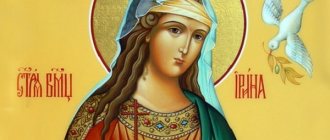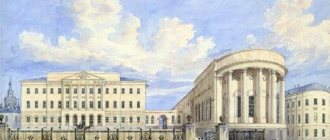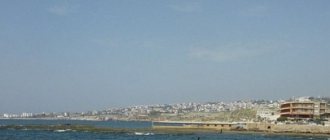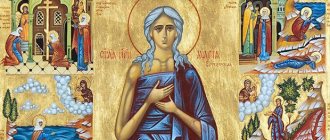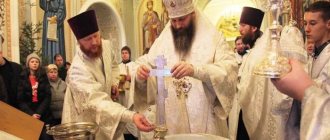Saint Irene was born at the end of the 1st century in Mygdonia. This was a time when Christians were persecuted and died painfully for their faith. The future preacher of Christianity was the daughter of the Thracian ruler of Mygdonia - Licinius. At first the girl was a pagan, like her parents. But later she converted to Christianity, for which she suffered at the beginning of the 2nd century. The Great Martyr Irene is the patroness of missionaries. Now people turn to her in prayer to strengthen faith in persecution and temptation.
Signs of Christ
Before her baptism, the Holy Great Martyr Irina bore the name that her parents gave her - Penelope. Historical reports say that the girl was distinguished by unearthly beauty. The father doted on his child. When Penelope was 6 years old, he built a luxurious country palace for her. In it, the girl lived with a teacher, whose name was Kariya, and the young women. The girl did not need anything: the ruler’s servants fulfilled her every whim. Every day a teacher, Elder Apelian, came to Penelope. He taught the girl various sciences. In addition, Apelian was a Christian (secret). He told his student about Christian virtues and the teachings of Christ.
When Penelope turned 12 years old, her father decided to marry her off. It was then that 3 birds flew into the girl’s room, with an interesting burden in their beaks. The first bird was a dove. He left an olive branch on Penelope's desk. The second bird - an eagle - gave the girl a flower wreath, and the raven left a small snake in her chambers. Penelope was very surprised when she discovered such “surprises”. But her teacher, Apelian, immediately understood the meaning of these signs. He explained that the dove represented Penelope's virtues through which she would receive God's grace in Baptism. For this, the Creator will crown her in his Kingdom with a wreath of glory. And the raven that brought Penelope the snake foreshadowed the persecution and sorrow that the girl would experience for her love for Christ.
Confrontations with kings
When her father came to her talking about the wedding, Irina told him that from now on she was the Bride of Christ and this infuriated him. He began to threaten his daughter with death for betraying the gods and refusing to marry. Irina bravely resisted him.
In his rage, Licinius threw his daughter under the hooves of wild horses, but by the grace of God the horses did not touch Irina, but turned around and trampled the king himself. Irina mourned her father for a long time and prayed for his resurrection, and the Lord heard her. The king, having resurrected, renounced the throne, converted to Christianity and retired to seclusion in a separate castle.
Zedekiah reigned on his throne, and he began to persuade Irina to return to the accepted gods in the country, to which the girl stubbornly answered no. The angry king ordered the stubborn woman to be thrown into a den with snakes. But the Lord protected her from this too, bringing her healthy and unharmed to freedom.
After some time, Zedekiah was overthrown from the throne, and his son was defeated while trying to win the throne back. The Lord struck his entire army with blindness, and Irina healed them all. But spiritual blindness remained and the king, instead of gratitude, pierced her feet with nails and gave her sandbags in her hands, forcing her to walk 5 kilometers.
For this, the king later received punishment from the Lord himself.
Acceptance of Christianity
After 3 birds appeared in Penelope’s room and Apelian explained the meaning of these signs, the girl asked her father for 7 days to think. During this time she had to choose her groom. But instead of reflecting on her future family life and choosing a spouse, Penelope decided to be baptized. The Apostle Timothy and his disciple Paul performed the rite of holy Baptism. The girl converted to Christianity and changed her name. Now her name was Irina. After some time, she publicly called herself a Christian. Licinius, Penelope's father, was enraged by his daughter's behavior and ordered her to be thrown under the hooves of running wild horses. However, not a single horse harmed the girl. On the contrary, one of the horses trampled her father. However, Saint Irene loved Licinius very much, so she began to pray for him. Soon her father was resurrected. After this event, Licinius and all his nobles believed in Christ. They all accepted Baptism, becoming Christians. Licinius left his ruling post and, together with his wife, moved to his daughter’s palace to serve God.
Penelope refused marriage and was baptized by the Apostle Timothy
After this, Penelope refused marriage, then she converted to Christianity. In Orthodoxy she took the name Irina.
Penelope refused marriage, then she converted to Christianity. The Sacrament of Baptism was performed by the Apostle Timothy
The girl tried to convert her parents to Christianity, the mother was very glad that the girl made such a decision, but the father prevented everything, he asked Penelope to worship the pagan deities. Penelope firmly stood her ground, then her father, angry, ordered her to be tied and thrown under the hooves of the horses.
The horses stood motionless, only one of them got loose and rushed at Lycia, severely damaging his hand. The girl was untied, through her prayer, Lykiy was healed, his hand remained intact and unharmed. On the same day, Lycias and his wife declared in front of all the people that they were renouncing the pagan gods.
The Torment of Saint Irene
After receiving Baptism, Saint Irene moved to the house of her teacher Apelian. There she prayed to the Lord day after day, read the Holy Scriptures and observed strict fasting. During the day the girl did not eat food at all, only in the evening she allowed herself some bread and water. Irina also slept little; her bed was an ordinary floor or earth. So Saint Irina spent 3 years in Mygdonia. During this time, the girl suffered due to the persecution of the changing rulers of the city. Almost every ruler tried to force Irina to worship pagan gods. But the girl was unshakable. Then Zedeki threw her into a ditch, which was filled with poisonous snakes, and left her there for 10 days. But the snakes did not bite Saint Irene, and the angel of God supported her when she was in the ditch. Seeing this, Zedekiy ordered the girl to be cut with a saw, but its edge became dull when the saw was brought to Irina. And the formidable ruler did not stop there. He ordered the girl to be tied to a mill wheel. But even then the Lord saved the life of his chosen one: no water flowed under the mill wheel. Thousands of people, seeing such miracles, renounced paganism and accepted Christianity. And when Zedeki once again expressed his indignation, the city residents stoned him. The cruel ruler was replaced by his son, Savah. He decided to avenge his father and gathered a huge army against the townspeople. But the Holy Great Martyr Irina read a prayer, and the army of Savakh, together with their ruler, became blind. After the incident, Savakh began to ask the girl for forgiveness, praying for healing. The generous Irina forgave him and restored his sight. But Savakh broke his promise and subjected the girl to further torture. This time he ordered nails to be driven into her feet, a heavy bag of sand placed on her shoulders, and in this form she was led out of town. Throughout the difficult journey, angels accompanied and supported Irina. And Savakh, to the surprise of the inhabitants of Mygdonia, suddenly died.
A prayer was written to the Great Martyr Irina - you can read it in front of the icon at home
A prayer was written to the Great Martyr Irina, which can be read in front of the icon at home.
Prayer:
O long-suffering and glorious Irino, the all-praised bride of Christ, the saint of God! You stand at the Throne of the Most Holy Trinity and enjoy indescribable bliss. Look mercifully upon us, who bring you this song of praise, ask us for mercy, remission of sins from the Most Blessed Lord, for we know, truly we know, for all that you desire, you can ask Him. Therefore, we humbly fall to you and ask: propitiate the Lord of heaven and earth, may He give us the spirit of your zeal for keeping His holy commandments, so that we may be able to lead our earthly career in a virtuous life, inherit the villages of paradise and there with you and all the saints glorify the Father and Son and Holy Spirit forever and ever. Amen"
By leaving a comment, you accept the user agreement
Miracles of Christ
During her stay in Mygdonia, Saint Irene preached the Christian faith and performed many miracles. With the help of prayer, she healed the sick, drove away demons and cleansed lepers. And one day the girl performed a real miracle: she resurrected a dead young man whose parents were mourning him. Later, Irina moved from Mygdonia to Calliope, and from there to Mesemvria. In every city of Thrace where Irina was, she preached Christianity. But even here it was not without torment. The city rulers were aggressive towards the teachings of Christ and his followers. They tried to burn the girl on a hot grate. But the Lord saved his chosen one from death. The biggest miracle with Saint Irene happened in the city of Mesemvria. The ruler of the city, Prince Savory, ordered the girl’s head to be cut off. And his order was carried out. And then they buried the holy martyr outside the city. But the Lord wanted Irina to continue preaching Christianity, so he resurrected her. The Almighty ordered his follower to return to Mesemvria. Residents of the city could not believe their eyes: in front of them was the deceased Irina. After what happened, Prince Savory and his people believed in the Lord God Christ and received Baptism. It was so difficult for the great martyr Irina to introduce people to the true faith.
Martyrs Agapia, Irene and Chionia of Aquileia
The holy martyrs Agapia, Irene and Chionia were sisters and lived at the end of the 3rd - beginning of the 4th century near the Italian city of Aquileia. They were left orphans at a young age. The girls led pious Christian lives and rejected the advances of numerous suitors. Their spiritual leader was priest Zinon. It was revealed to him in a dream vision that he would soon die, and the holy virgins would be taken to be tortured. The same revelation occurred to the Great Martyr Anastasia († c. 304, commemorated December 22/January 4), who was in Aquileia, who was called the Pattern Maker because she fearlessly visited Christians in prison, encouraged them and helped them. Great Martyr Anastasia hurried to the sisters and urged them to courageously stand up for Christ. Soon what was predicted in the vision came true. The priest Zenon died, and the three virgins were captured and sent to trial before the emperor Diocletian (284–305).
Seeing the young beautiful sisters, the emperor invited them to renounce Christ and promised to find noble suitors from his retinue. But the holy sisters answered that they had one Heavenly Bridegroom - Christ, for whose faith they were ready to suffer. The emperor urged them to renounce Christ, but neither the older sisters nor the youngest of them agreed. They called the pagan gods idols made by human hands and preached faith in the True God.
By order of Diocletian, who went to Macedonia, the holy sisters were also taken there. They were handed over to the ruler Dulcytius for trial.
When he saw the beauty of the holy martyrs, he was inflamed with unclean passion. He took the sisters into custody and told them that they would receive freedom if they agreed to fulfill his wish. But the holy martyrs replied that they were ready to die for their Heavenly Bridegroom - Christ. Then Dulcitius decided to secretly take possession of them by force at night. When the holy sisters got up at night to pray and praised the Lord, Dulcytius crept to the door and wanted to enter. An invisible force struck him, he lost his mind and rushed away. Finding no way out, the tormentor on the way ended up in a kitchen where there were cast irons, frying pans and cauldrons, and became all dirty with soot. Servants and warriors hardly recognized him. When he saw himself in the mirror, he thought that the holy martyrs had bewitched him, and decided to take revenge on them.
At the trial, Dulcitius ordered the holy martyrs to be naked before him. But the soldiers, no matter how hard they tried, could not do this: the clothes seemed to have grown to the bodies of the holy virgins. During the trial, Dulcitius suddenly fell asleep and no one could wake him up. But as soon as they brought him into the house, he immediately woke up.
We advise you to study the Icon “Softening Evil Hearts”
When Emperor Diocletian was informed about everything that had happened, he became angry with Dulcetius and handed the holy virgins over to judge Sisinius. Then he began his interrogation with his younger sister Irina. Convinced of her inflexibility, he sent her to prison and tried to force the saints Chionia and Agapia to renounce. But it was impossible to persuade them to renounce Christ, and Sisinius ordered the burning of saints Agapia and Chionia. The sisters, having heard the verdict, thanked the Lord for the crowns of martyrdom. In the fire, Agapia and Chionia went to the Lord in prayer.
When the fire went out, everyone saw that the bodies of the martyrs and their clothes were not scorched by fire, and their faces were beautiful and calm, like those of people who had fallen asleep in a quiet sleep. The next day, Sisinius ordered Saint Irene to be brought to trial. He frightened her with the fate of her older sisters and persuaded her to renounce Christ, and then began to threaten to hand her over to be mocked in a whorehouse. But the holy martyr answered: “Let my body be given over to violent desecration, but my soul will not be desecrated by renouncing Christ.”
When the warriors of Sisinius led Saint Irene to the fornication, they were overtaken by two bright warriors and said: “Your master Sisinius commands you to bring the girl to a high mountain and leave there, and then come to him and report on the fulfillment of the order.” The warriors did just that. When they reported this to Sisinius, he became furious because he had not given such an order. The bright warriors were Angels of God who saved the holy martyr from desecration. Sisinius with a detachment of soldiers headed towards the mountain and saw Saint Irene on its top. For a long time he searched for the way to the top, but could not find it. Then one of the warriors wounded Saint Irene with an arrow from a bow. The martyr shouted to Sisinius: “I laugh at your powerless malice and go clean, undefiled to my Lord Jesus Christ.” Having thanked the Lord, she lay down on the ground and gave up her spirit to God the day before Holy Easter († 304).
The Last Days of Saint Irene
Saint Irene of Macedon died in the city of Ephesus. The girl foresaw her death. A few days before her death, Irina, together with her teacher, Elder Apelian, went outside the city to one of the mountain caves. Having entered there, Irina ordered her companions to close the cave entrance with a heavy stone. Here she died in prayer. It happened on May 5th. On the 4th day, Christians came to the cave to take away the body of Saint Irene. But when they rolled away the stone, they saw that there was no one there. People realized that the girl’s body was taken to heaven by the Almighty. During her stay in Ephesus, the follower of Christ did not stop preaching Christianity. Thanks to her, many people believed in the Lord God and received Baptism. By the way, the girl was transported to Ephesus from Mygdonia on a cloud. Some sources say that Saint Irene preached the Gospel among the Slavic people, and was burned in Thessaloniki.
Life
The Great Martyr Irina was born into a family of a noble family in the first century AD. Her parents gave her the name Penelope, which she bore before her baptism. Her father was the ruler of one of the cities of Byzantium and, being a pagan, completely denied the existence of God.
For his beloved daughter, he built a separate house, which was not inferior in luxury to the palace in which she lived with her teacher. Young Penelope was educated by teacher Apelian, who taught her secrets and about the Christian faith.
When the girl reached the right age, her parents became concerned about her future and decided to marry her off. However, this event was not destined to happen. God sent the beauty a sign, and, having interpreted it with the help of Apelian, she firmly decided to devote her life to serving the Lord.
The three birds that the Almighty sent to Penelope carried certain messages. The first of them was a dove; in its beak it held an olive branch, which symbolizes purity and grace. The second is an eagle with a wreath, personifying the strength of spirit received through worship. The third is a black crow with a snake as a symbol of earthly temptations and unclean intentions.
The disciple of the Apostle Peter, Timothy, performed the baptism ceremony for the girl, after which she began to bear the name Irina. On icons she is often depicted with three birds, which convinced her of her beliefs and desire to serve God.
Despite the fact that initially the parents did not speak out against the girl’s choice, over time her father demanded that she serve the pagan gods. Having received a refusal, the angry man ordered young Irina to be imprisoned in a dungeon with snakes for ten days. The guardian angel helped the girl remain unharmed. But her torment did not end there.
Her father Licinius ordered the poor girl to be executed by setting horses on her. However, the horses did not budge, and only one of them rushed to Licinius and pulled out his hand. Irina’s unshakable faith in the Lord and sincere prayers helped the man survive. The miracle that happened made the girl’s parents and thousands of other people believe in God.
Throughout her life, the great martyr was subjected to torture, cruel torture and a sentence of merciless execution. But the Almighty was always there and helped to overcome all difficulties. Irina helped hundreds of thousands of people find faith in Jesus Christ.
The saint died at the age of 97, having gone into one of the caves, the entrance to which was closed by her disciples at her request. After some time, people entered the cave, but Irina’s body was not found there. Thus, it is believed that she has found her place next to God and continues to help people who turn to her with prayers.
Temples
In Constantinople, several beautiful churches were built in memory of the follower of Christ. In Pokrovskoye (Russia, Moscow) you can find the Church of St. Irene. The chapel of the holy martyr was added in 1635 to the parish church of St. N. the Wonderworker. In 1790-1792, a church was erected with chapels of the holy martyrs Irina and Catherine. People began to call the temple “Pokrovskaya Irina the Martyr.” In 1891, the church was rebuilt and significantly expanded. During the revolution of 1917, the church was closed and the building itself was partially destroyed. And only in 1992 the holy building was returned to the church. Now the temple is the only one in Moscow consecrated in honor of St. Irene. Now there is a busy life in it. A Sunday school has been opened at the church, where theology is taught, a library, computer classes, and a film library are created. But the Church of the Intercession of St. Irene is not famous for this, but for its beautiful incense, which is called “Irinin”. Here the priest was able to create a laboratory where he studies ancient recipes for preparing fragrant compositions. The aroma of Irina’s incense simply fascinates parishioners. A church in honor of St. Irene can also be found in Volgovo (40 km from St. Petersburg). This village is small, as is the church itself. Now in Volgovo work is underway to reconstruct and restore it. In the future, it is planned to open a museum of Orthodox culture there, for which there are plenty of exhibits and materials collected.
Faith, love, peace and enlightenment of the Holy Great Martyr Irene
On May 5/18, at the end of the 1st century, in the city of Ephesus, the Holy Great Martyr Irina reposed in the Lord. She met in this city her teacher Apelian, a man dear to her from childhood, who gave her an excellent education for those times, taught her “book wisdom,” told her about Christ and led her to the Kingdom of Heaven. She herself chose a cave-coffin in the rock, allowing the stone to be rolled away on the fourth day. After this period, her body was not found in the tomb. Probably, the Lord took His faithful confessor to Heaven along with the body, like the prophet Elijah, like the Apostle John.
Came to give peace
The Holy Great Martyr Irina lived in apostolic times and was honored to receive baptism with the name Irina from the disciple of the Apostle Paul, Timothy.
For confessing her faith in Christ and refusing to worship idols, Saint Irene was tortured by six rulers in different cities, including her own father. She was warned about the upcoming torment by a raven who flew into her room and brought a snake in its beak. The victory over her enemies - human passions - was announced to her by an eagle, which brought a wreath of flowers in its beak as a symbol of glory for her future exploits in the name of the Lord. Steadfast in her faith, she immediately forgave the offenders, resurrected and healed them. She combined her love for Christ and people with the courage of a warrior. Some of her tormentors, seeing the power of her faith, armed with the help of God (saws could not saw, and fire could not burn her body; wild horses did not trample her, but killed her tormentor, etc.), were baptized along with the inhabitants of the subject cities. After suffering from his father, Licinius, 3 thousand people believed in Christ; after the torment of Zedekiah - 8 thousand people; after the torment of Savakh - 30 thousand; after the torment of Numerion - 100 thousand. The Angel of the Lord was constantly with her: comforting and helping. In prison, Jesus Christ visited her, strengthening her for future trials. If Saint Irene had not been glorified among the Great Martyrs (martyrs of noble birth, who not only accepted Christ with all their hearts, but also renounced their existing earthly blessings), then one could count her among the Equal-to-the-Apostles (she led so many people to faith in Christ ).
The name “Irina” is translated from Greek as “peace and tranquility.” It is no coincidence that even before Penelope’s baptism (that was the saint’s name before baptism), the first of all the birds to fly into her room was a dove - a bird symbolizing peace. The dove brought her an olive branch as a symbol of God's grace. An angel who visited the girl even before baptism announced that she would be “many refuge and a peaceful haven,” and therefore after baptism she would be called Irina. The Holy Great Martyr Irene gives us PEACE in the many meanings of this word: as inner personal peace and as peaceful coexistence with other people (“peace with oneself” and “peace with others”).
"Special Irininsky spirit"
I experienced a special spirit of peace when I came for the first time to the Church of the Great Martyr Irina in Pokrovskoye on Bright Week this year. After the Liturgy, I wanted to stay longer. While I was standing at the icon, a woman named Photinia came up to me and shared the story of her life: her son, a 13-year-old boy, Tikhon, was seriously ill. She finds peace and tranquility by turning specifically to Saint Irene and being in this particular temple. By the way, the majority of parishioners testify to the particularly gracious, tranquil atmosphere of the Church of the Holy Great Martyr Irene in Pokrovskoye, calling this phenomenon “the special spirit of Irene.” In Russia there are not many religious sites dedicated to the Great Martyr Irina - only 17, but all of them are iconic: 10 churches, 1 chapel and 6 chapels in other churches, mainly monastic ones (in Pafnutyevo-Borovsky, Kirillo-Belozersky, Uglichsky, Knyaz- Vladimir Irkutsk Monastery and Trinity-Sergius Lavra). 7 churches were built in Moscow, Kerch, Volgovo village, Leningrad region, village. Korsun, Oryol region, Irinovka village, Leningrad region and in Rostov-on-Don. 3 churches are currently being built in the village of Mirny, Ulyanovsk region, in the city of Pushkin, Moscow region and in Kaliningrad.
Temples dedicated to Saint Irene in Rus' were built by the bearers of this name themselves or their relatives. The first temple dedicated to Saint Irene was built in the early period of Christianity in Rus' in Kyiv (11th century) by Grand Duke Yaroslav the Wise and his wife Princess Irina (Ingigerda - daughter of the Norwegian king Olaf). The temple was destroyed during the invasion of Batu Khan. In the 19th century, a monument (“Irininsky Pillar”) was erected on the site of the temple, in 1855 it was consecrated as a chapel, and in 1932 it was demolished. Only memory remains of the first church dedicated to the Holy Great Martyr Irene.
The first temple dedicated to Saint Irina was built by Grand Duke Yaroslav the Wise and his wife Princess Irina
Temples in honor of the same saints were built not only by members of the royal family. Active builders of temples in the 18th–20th centuries were merchants. For example, the chapel (now a temple) at the Kerch hospital was built by the Moscow merchant Irina Forofontova in 1891.
In Moscow, both churches dedicated to the Great Martyr Irina were built in the 17th century. One - on Vozdvizhenka (1629) by boyar V.I. Streshnev, probably a relative of Princess Irina’s mother, Tsarina Evdokia Lukyanovna (nee Streshneva). Another - in the village of Pokrovskoye - by parents - Tsar Mikhail Fedorovich and Tsarina Evdokia Lukyanovna (1635) for the name day of the 8-year-old princess Irina Mikhailovna. So they thanked God for the birth of their first child and appealed to Saint Irene to take their daughter under her protection.
The chapel in the name of the Holy Great Martyr Irina in the Pafnutyevo-Borovsky Monastery was built by order of the matured Irina Mikhailovna during the reign of her brother, Tsar Alexei Mikhailovich.
The heyday of the temple in Pokrovsky occurred during the life of Irina Mikhailovna and the reign of her father Mikhail, brother Alexei and eldest nephew Fyodor Alekseevich. After the fire during the reign of Catherine II, the temple was rebuilt and, despite its renaming into the Church of the Life-Giving Trinity with chapels dedicated to the holy great martyrs Irina and Catherine, the name “Irininsky” was firmly assigned to this temple. In addition, the street on which the temple was located was named Irininskaya, and the three lanes adjacent to the street began to be called 1st, 2nd and 3rd Irininsky. By the 19th century, the village of Pokrovskoye had become an industrial outskirts of Moscow, and the church from the royal house gradually turned into a parish church. At this time, the number of parishioners increased, and by order of Emperor Alexander III, the temple was rebuilt and significantly increased in size. Distinctive features of the temple were the presence of a special small room for confession, as well as a rare stone statue of the “Savior in Prison,” located in a niche with an iron grate.
The Irininsky Church was also preparing for the celebration of the 300th anniversary of the House of Romanov in 1913: in 1911, a new four-tiered iconostasis in the Old Russian style was installed. A reminder that the temple was originally the house temple of the Romanovs is the icon now present in the temple depicting the images of Nicholas the Wonderworker and Queen Alexandra - the heavenly patrons of the last Russian Emperor Nicholas II and Empress Alexandra Fedorovna, who continue to remain invisibly in the Irininsky Church.
In the histories of some churches of the Holy Great Martyr Irene, an interesting pattern is noted: churches at different times were connected in different ways with the mission of international unification. For example, the Church of the Great Martyr Irina in Volgovo, built in 1812 by the former Minister of Finance Fyodor Golubtsov in his estate and consecrated as a house church, in 1909 became the only Russian-Finnish Orthodox church in Russia and a center of missionary activity to spread Orthodoxy among Finns and Estonians; Divine services were held here in Finnish and Russian.
The peculiarity of the Irininsky temples: they are associated with the mission of uniting people of different nationalities
In 2013, with the blessing of Patriarch Kirill of Moscow and All Rus', a representative office of the Belarusian Exarchate was opened at the Irininsky Church in Pokrovskoye. The rector of the temple was Archbishop of Vitebsk and Orsha Dimitry (Drozdov), a wise clergyman and experienced preacher. The Holy Great Martyr Irina again found herself at the center of the unification of now different Orthodox countries - Russia and Belarus, which were previously a single whole.
Following the example of the heavenly patroness
The Holy Great Martyr Irene was the first saint glorified with this name, becoming the patroness of all the saints and non-saints Irene who followed her.
It seems that each of Irins carries within herself some specific traits characteristic of their heavenly patroness. Saint Irene of Corinth (Greece, † 258), Saint Irene of Egypt (III century), Saint Irene of Aquileia (Italy, III - early IV centuries) are glorified as martyrs. They, like their heavenly patroness, the Great Martyr Irina, courageously endured torment for Christ. It is noteworthy that Irene from Aquileia, together with the sisters Agapia and Chionia, was taken for trial to Macedonia - the homeland of the Great Martyr Irene, where they gave up their spirit to the Lord, while Saint Irene - the day before Holy Easter († 304).
The Hungarian princess Irina-Piroshka (11th century), who became the Byzantine empress - the wife of Emperor John Komnenos - was distinguished by her kind disposition and meekness. She gave birth to and raised 8 children and fully demonstrated herself as a peacemaker: she took care of the Hungarian pilgrims who arrived in the Holy Land. Together with her husband, she founded the temple and monastery of the Savior Pantocrator in Constantinople, and at the end of her life she took monastic vows with the name Xenia and was glorified among the venerables.
Princess Irina (Ingigerda), the daughter of the Swedish king Olaf, received a brilliant education for those times, like her heavenly patron, the Great Martyr Irina. She was educated, free, like a true woman of the Viking Age, took an active part in public life, was distinguished by her intelligence, courage and significant influence on those around her, and often acted as a peacemaker. People turned to her to resolve problems. The princess took an active part in the construction of churches. In 1054, after the death of her husband, she took monastic vows with the name Anna. This was the first tonsure in the grand ducal house. In the 15th century, Anna of Novgorod was canonized as a saint in the rank of the faithful.
After the death of her husband, she took monastic vows with the name Anna - this was the first monastic vow in the grand ducal house
Irina Godunova - the wife of the last tsar from the Rurik dynasty, Fyodor Ioannovich (son of Ivan the Terrible) - lived in love and harmony with her husband. Just like the Great Martyr Irina and Princess Irina (Ingigerda), she was a brave and intelligent woman. She received the Ecumenical Patriarchs in the Golden Tsarina Chamber and was not afraid to make a welcoming speech. She said the word, stepped back and stood between her husband and brother. This was the first case of a public speech by the Russian Tsarina (almost the only one at that time) recorded in the sources. Foreign guests admired the queen's intelligence. Tsar Fyodor Ioannovich, despite the entreaties of the boyars, did not send his wife to the monastery, and after the death of her husband she renounced power, handed it over to her brother Boris Godunov and took monastic vows in the Novodevichy Monastery with the name Alexander.
Irina Mikhailovna Romanova also had some common features with her heavenly patroness. Both Irinas were born and raised in royal families 1600 years apart. One - in the 1st century, in the family of the ruler Mageddon Licinius, the other - in the 17th century in the family of the Moscow Tsar Mikhail Fedorovich. The father imprisoned one in a tower so as not to show people her beauty ahead of time; the other grew up in solitude in the women's half of the royal palace, away from prying eyes. One refused to get married, wanting to become the bride of Christ; the other could not get married, since there were no longer Orthodox princes in the world.
The Holy Great Martyr Irina thought about the meaning of life and subsequently spoke passionately and boldly that the meaning of life is Christ, and as a result of her preaching, thousands of people believed and were baptized. Irina Mikhailovna preached Christ through quiet care for her loved ones. During the period of the schism, noblewoman Morozova and archpriest Avvakum wrote letters to Irina Mikhailovna, knowing her peacemaking attitude, hoping through her to influence the tsar.
When you read the stories of all these women, you get the feeling of the invisible presence of the Great Martyr Irina in their lives. She has always been and is in my life, even when I didn’t know about it.
My Great Martyr Irina
By decree of the Presidium of the Supreme Council of the Kazakh SSR dated May 18, 1945, the workers' village of Makinka was transformed into the city of Makinsk. And again Saint Irene and Mir go hand in hand. This is my hometown in distant Kazakhstan, I was born many years after this day, which means that Saint Irene was already my patroness by birthright in this city, and I only learned about this date in 2022, on the 75th anniversary of the city. Mom said she didn’t remember why they called me that: it wasn’t that she liked the name very much; no one from the outside advised; There were no people with that name in my family. They just named it and that’s it. Now, from the height of her years, my mother says: “It was God’s will, not ours.” Quite often, when we do God’s will, we don’t realize why we do it, but we do it because we think it’s right. In secular life we could call this intuition, but in spiritual life we understand that there is a special Providence of the Lord for each person. About everyone! Without exception! One of the first Providences about me: my name is Irina.
In Makinsk there was a wonderful school with wonderful teachers, the level of training in which allowed children from the outback of Kazakhstan to enter various universities in the country. In this small town there were many exiles and their descendants - educated people from different cities of our homeland, as well as people of different nationalities (Russians, Ukrainians, Belarusians, Germans, Ingush, Koreans), whom, as I now understand, the saint took under her protection Great Martyr Irina, united, pacified; Through her prayers, our cultural and scientific enlightenment took place, and little by little she led each of us to God.
She was with me in Tselinograd when I was baptized in 1991, as a student. I don’t remember why I decided to be baptized, there were no special reasons, I just realized that I wanted to do it. It was on that day that I bought an icon of the Holy Great Martyr Irene, but for the time being I didn’t even realize that I needed to read her life.
On May 18, 2016, while attending the solemn Liturgy on the occasion of the 25th anniversary of the resumption of services in the Church of the Savior Not Made by Hands in Perovo, now my parish church, I realized: it turns out that I was baptized in Kazakhstan approximately at the moment when in this church in Moscow in On the day of St. Irene, the first Liturgy took place.
St. Irene's Day is celebrated in my Spassky Church especially solemnly, with a procession of the cross. Saint Irene is considered one of the patrons of our temple, since services in the temple resumed on May 18, 1991. Our heavenly patroness gathered under the shadow of this temple a lot of Irins, different in character, with different destinies.
I first came to this church for the Christmas Liturgy in 2014, on the same day I met there a student from my first, favorite graduating class and a colleague from the Orthodox tour guide course. They reported a special veneration of St. Irene in this temple, and this was a revelation for me. Slowly, progressively, we move towards some important stages of our lives, moving from one to another, armed with new experience.
On May 18, 2010, on St. Irene’s Day and Museum Day, I first came to the museum pedagogy department in Kolomenskoye.
In the summer of 2011, I really wanted to go to Greece, but it turned out that prices had increased significantly, and I was recommended to go to Turkey. And although I didn’t like going there, this time I agreed, and even without internal resistance. Arriving in Marmaris, I immediately went to sign up for excursions and chose a trip to Ephesus. Then I knew nothing about the city of Ephesus: neither that it was the last place of residence of the Most Holy Theotokos, nor that the last earthly sermon of my heavenly patroness, the Holy Great Martyr Irene, took place in this city. There she rested. I saw the ruins of an ancient city in the open air and felt its character. The Most Holy Theotokos and the Holy Great Martyr Irina became even closer to me.
How little we value our patron saints, know little about them, pray to them little, talk little about them, love them little! But even when we forget about them, they do not forget about us. Thank God for everything! Thanks be to Him for our heavenly patrons!
Temple of Saint Irene in Istanbul
But the most magnificent Church of Hagia Irene is located in Istanbul (Türkiye). However, it is dedicated not to Irene of Macedonia, but to the Great Martyrs Sophia and Irene of Egypt. This is not only the most ancient and beautiful temple in the city, but also the calling card of a large metropolis. The Byzantine church is located in the center of Istanbul - the Sultanahmet district. The church was built in the 4th century on the site of the ancient temple of Aphrodite. Initially, the holy building was considered the main church of Constantinople. In 532 the temple was burned, and in 548 it was rebuilt under the holy emperor Justinian. In 740, the Church of St. Irene was severely damaged by an earthquake. In 1453, Constantinople was conquered by the Ottomans, but they decided not to convert the temple into a mosque. From the 16th to the 18th centuries, the Byzantine church was used to store weapons, and in 1846 it was turned into an Archaeological Museum. In 1869, the temple was transformed into the Imperial Museum, and in 1908 - into a military museum. Today, the Byzantine temple serves as a concert hall due to its impressive size and excellent acoustics. In 2000, Faruk Saras, a famous Turkish couturier, organized a modeling show there, which he dedicated to the history of the Ottoman Empire. The Istanbul Church of St. Irene is unique in that it has been preserved in almost unchanged condition. Thousands of tourists come to see it, the largest percentage of whom are Christians.
What does Saint Irene help with?
Over the years of her missionary activity, the holy martyr Irene was able to convert more than 10,000 pagans to Christians. These included not only ordinary people, but also rulers of different cities. The icon of St. Irene of Macedon is found in almost every Orthodox church. People turn to her to ask for health, vitality, family well-being and confidence. The memory of the Holy Great Martyr Irina is celebrated on May 5 (the day of her death). According to the new style - May 18. In honor of the icon of St. Irene, an estate was built in Moscow, which later went to the Naryshkins. Saint Irene patronizes many. What does she help with? The Holy Great Martyr protects from various kinds of misfortunes. Prayer to Saint Irene helps strengthen family relationships. The saint also helps to gain confidence and achieve career success.
Great Martyr Irene of Macedon - they pray when faith and fortitude are impoverished
What does Saint Irene help with, what do they pray to her for? Women bearing the name Irina should turn to their intercessor in all troubles and joys.
Sometimes, if it is not possible to read prayers, you can simply ask the saint in your own words. The most important thing is to ask from a pure heart, and the saint will definitely help you.
If you decide to read a prayer, then you need to read it out loud, clearly, concentrate only on it, without being distracted by other matters. When reading a prayer, you need to think about what you are asking the saint for.
Patron Saint Irene of Macedon - the closest heavenly helper
They pray to Irene the Great:
- in physical and mental illnesses that are accompanied by severe pain;
- with depletion of faith and fortitude;
- when the soul is enslaved by passions, dark forces;
- about a successful marriage and further happy life in marriage;
- in search of and settling into a new job.
The memory of the saint was honored in ancient Byzantium and Persia. In Constantinople alone, several churches were built in memory of this saint.
A troparion and kontakion were written for the Holy Great Martyr Irene, which are sung during the service. You can read it at home in front of the icon.
Troparion, tone 4
Your Lamb, Jesus, Irina, calls with a great voice: I love You, my Bridegroom, and, seeking You, I suffer, and I am crucified, and I am buried in Your Baptism, and I suffer for Your sake, for I reign in You, and I die for You, yes and I live with You, but as an immaculate sacrifice, accept me, sacrificed to You with love. Through prayers, as the Merciful, save our souls.
Kontakion, tone 4
Virginity is replete with kindnesses, virgin, you were the most beautiful with suffering, Irino, stained with your flowing blood, and you have overthrown godlessness with charm. For this reason, you accepted the honors of victory by the hand of your Creator.
Icon of Saint Irene of Egypt
The early Christian missionaries had a difficult journey. Saint Irene of Egypt, together with other followers of Christ, brought the good news to the Egyptian people. She preached the Christian faith and performed miracles. Many Egyptians in those days were baptized and believed in the true God. However, Saint Irene’s sermon did not last long. In one of the Egyptian cities she was captured along with another missionary, Saint Sophia. After numerous tortures, the girls were beheaded. Years passed, and only during the reign of Emperor Constantine the Great the relics of Saints Sophia and Irene were transported to Constantinople. Subsequently, a temple was built in Byzantium in honor of the great martyrs.
The icon of St. Irene of Egypt helps a person throughout his life. The Holy Great Martyr intercedes for people in their sorrow, thanks the Almighty for the joy sent down. Prayer to Saint Irene of Egypt protects from troubles, troubles, and helps to avoid sinful acts. The patron saint protects people from evil and disease. The holy martyr Irina prays for all Orthodox people before the Lord God. Her icon is of great value for a person. Priests recommend having it in the home of those whom it protects. The Orthodox holiday in memory of St. Irene of Egypt is celebrated on September 18 (new style - October 1).
The meaning of the name Irina
Translated from ancient Greek, the name means “peace, tranquility.” A girl named Irina has such qualities as independence, mobility, determination, firmness, and cheerfulness. The name Irina “blesses” its owner with an analytical mind and an excellent sense of humor. In adult life, Irina devotes a lot of time to her career. They often become excellent leaders thanks to a combination of internal balance, prudence and a sense of humor. Irins are good diplomats and psychologists. They feel the interlocutor well and know how to “tune in to his wavelength.” As a rule, girls named Irina are not limited to housework. They prefer to combine career and family.
